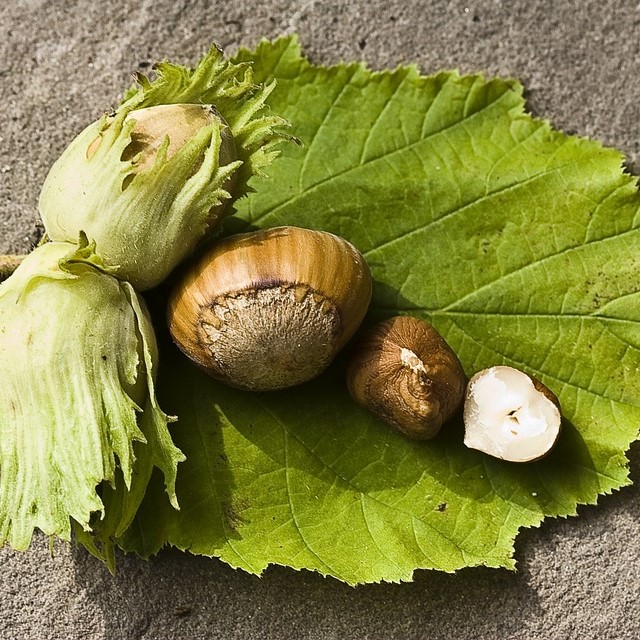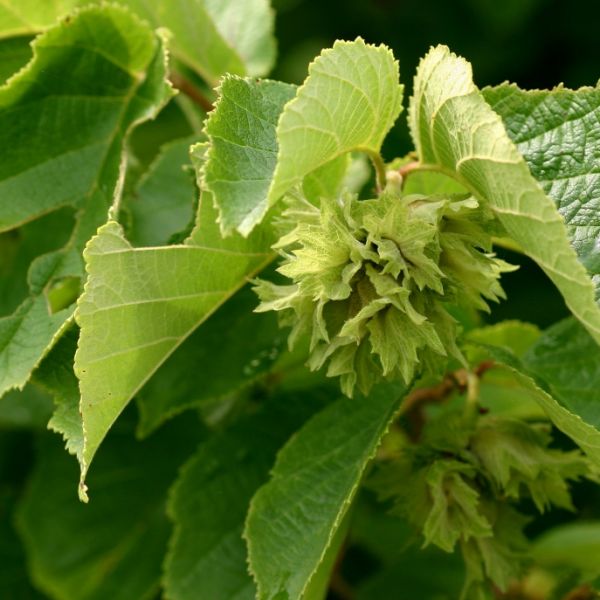

American Hazelnut Filbert Tree
Corylus americana
98 reviews
American Hazelnut Filbert Tree
Corylus americana
98 reviews
2.5 Gallon
We are sorry, product is currently out of stock due to seasonal availability. Please check the "Related plants available in your area" section below
Not just beautiful - intentionally selected by ShrubHub's 3D landscape design team to fit real-world spaces and maximize yard potential.
Why American Hazelnut Filbert Tree?
Hazelnut (Corylus americana) is a deciduous tree native to North America. It is known for its tasty nuts, which are enclosed in a hard, round shell. Hazelnuts are widely consumed and have numerous health benefits. They are rich in vitamins, minerals, healthy fats, and antioxidants. Hazelnut trees also provide shade, attract wildlife, and contribute to soil stability, making them valuable additions to landscapes.
Sunlight
Hazelnut trees require full sun exposure to thrive and produce abundant crops. They need at least six to eight hours of direct sunlight per day to ensure optimal growth and development.
Watering
Hazelnuts generally require regular and consistent watering, especially during their first few years of growth. They prefer moist soil but should not be left in standing water. Adequate watering helps promote healthy growth and higher nut yields.
Fertilizing
Hazelnut trees require nitrogen-based fertilizers to promote healthy growth and fruit development. However, the specific fertilizer requirement may vary depending on factors such as soil type, age of the tree, and local climate conditions.
Hazelnut (Corylus americana)
Hazelnut, scientifically known as Corylus americana, is a small deciduous tree that belongs to the birch family (Betulaceae). It is native to eastern North America and is found in regions with moist, well-drained soil such as woodlands, forests, and riverbanks. Hazelnut trees are prized for both their delicious nuts and ornamental value.
Description
The hazelnut tree typically reaches a height of 12 to 20 feet with a similar spread. It has a dense, rounded crown and a smooth gray bark. The leaves are broadly oval, alternate, and toothed with a vibrant yellowish-green color. During fall, the foliage brings a beautiful display of golden shades. In late winter or early spring, depending on the region, the tree produces pale yellowish catkins, which are pendulous clusters containing male flowers.
Nuts
The hazelnut tree produces small, round nuts encased in a husk or burr. The nuts are typically 0.5 to 0.8 inches in diameter and have a hard, woody shell that protects the tasty kernel inside. Hazelnuts have a rich, buttery flavor and can be consumed raw, roasted, or used as an ingredient in various culinary preparations.
Cultivation
Hazelnut trees prefer well-drained, slightly acidic soil and thrive in full sun or partial shade. They have a moderate growth rate and can tolerate temperatures down to -20°F (-29°C). Hazelnuts are often propagated by grafting or from suckers that emerge around the base of the tree.
Uses
Hazelnuts have a wide range of applications. They are popular ingredients in confectionery, baking, and ice cream. Hazelnut oil, extracted from the nuts, is also used in cooking and as a flavoring. Additionally, hazelnuts provide essential nutrients and serve as a beneficial food source for wildlife, attracting various birds and mammals.
Health Benefits
Hazelnuts are not only delicious but also offer several health benefits. They are a great source of healthy fats, antioxidants, fiber, and essential minerals such as magnesium and phosphorus. Consuming hazelnuts may help in improving heart health, reducing inflammation, promoting healthy digestion, and enhancing brain function.
Conclusion
Hazelnut, with its attractive appearance, tasty nuts, and various uses, is a desirable tree for both garden landscapes and food production. Whether you fancy its culinary potential or want to enjoy its ornamental qualities, the hazelnut tree is a versatile and worthwhile addition to any garden or natural setting.
Plant Information:
| Botanical Name: | Corylus americana |
| USDA Zones: | 4 - 9 |
| Water: | Moderate |
| Exposure: | Full Sun |
| Soil Needs: | Widely Adaptable |
| Mature Height: | 8 - 15 feet |
| Mature Spread: | 8 - 15 feet |







Pollination Info
Pollination Information for Hazelnut (Corylus americana)
Hazelnut (Corylus americana) is a deciduous shrub native to North America. It is also commonly known as American hazelnut or American filbert. Pollination plays a vital role in the production of hazelnuts, as it is required for fertilization and fruit development. Here are some important details regarding the pollination of hazelnut plants:
Flower Structure
Hazelnut flowers are monoecious, which means that both male and female flowers are present on the same plant. They typically appear in small clusters known as catkins, which hang from the branches. Male catkins are elongated and produce pollen, while female catkins are shorter and contain tiny, red, thread-like stigma that catch the pollen.
Pollination Mechanisms
Hazelnut plants exhibit anemophilous pollination, meaning their pollen is spread by wind. Since these plants do not rely on insects or other animals for transfer, they do not produce showy, fragrant flowers to attract pollinators. Instead, they produce abundant pollen, hoping some will be carried to nearby female flowers by air currents.
Pollination Requirements
Hazelnuts are primarily wind-pollinated, but they still benefit from having other hazelnut trees nearby for successful cross-pollination. For optimal nut production, it is recommended to have at least two compatible hazelnut varieties within close proximity (around 50-100 feet). This ensures a greater chance of pollen transfer between different trees and improves fruit set.
Timing and Factors Affecting Pollination
Hazelnut flowers typically bloom in early spring before the leaves fully emerge. The timing of bloom is crucial for successful pollination, as it needs to coincide with the release of pollen from the male catkins. Factors such as temperature, moisture, and wind conditions during the flowering period can influence the effectiveness of pollination. Wet or windy weather can hinder pollen movement, while hot or dry conditions may cause the flowers to dry out before pollination occurs.
Self-Fertility and Cross-Pollination
While some hazelnut varieties are self-fertile, meaning they can produce fruit on their own, cross-pollination is advantageous for increasing nut yields and ensuring better quality nuts. Cross-pollination occurs when pollen from one variety is carried to the female flowers of a different variety. Therefore, for optimal results, it is recommended to plant multiple hazelnut cultivars together to enhance cross-pollination.
FAQ
Frequently Asked Questions about Hazelnut (Corylus americana)
1. What is Hazelnut (Corylus americana)?
Hazelnut, scientifically known as Corylus americana, is a deciduous shrub native to North America. It is widely cultivated for its edible nuts and has various uses in culinary preparations.
2. How tall does a Hazelnut shrub typically grow?
A mature Hazelnut shrub can reach a height of about 10 to 15 feet (3 to 4.5 meters), although there are instances where it can grow taller under optimal conditions.
3. What is the best climate for growing Hazelnuts?
Hazelnuts thrive in temperate climates with moderate rainfall and well-drained soil. They are adaptable to a wide range of soil types but prefer slightly acidic to neutral pH levels.
4. When is the best time to plant Hazelnut trees?
The best time to plant Hazelnut trees is in early spring or fall when the soil is not too cold or waterlogged. This allows the roots to establish before extreme weather conditions.
5. How long does it take for a Hazelnut tree to bear fruits?
A Hazelnut tree typically takes three to five years to begin bearing fruits. However, the full nut production is usually achieved after seven to eight years of growth.
6. Are Hazelnuts self-pollinating or do they require cross-pollination?
Hazelnuts are usually not self-pollinating and require cross-pollination between different cultivars or varieties for optimal nut production. It is recommended to plant at least two compatible varieties within proximity for successful pollination.
7. How do I harvest Hazelnuts?
Hazelnuts are ready for harvest when the nuts turn brown and the husks start to split open. Collect the nuts by either shaking the branches or picking them up from the ground. Remove the husks and allow the nuts to dry before storage.
8. What are some common pests and diseases that affect Hazelnut trees?
Some common pests that affect Hazelnut trees are aphids, mites, and squirrels. Diseases like Eastern Filbert Blight, powdery mildew, and bacterial blight can also pose a threat. Regular inspection, good sanitation practices, and appropriate treatments can help minimize these issues.
9. Can Hazelnuts be consumed by people with nut allergies?
Hazelnuts are considered tree nuts and can cause allergic reactions in individuals with nut allergies. It is important to exercise caution and seek medical advice if you have known nut allergies before consuming Hazelnuts or any products containing them.
10. What are some culinary uses for Hazelnuts?
Hazelnuts have a rich, slightly sweet flavor and are commonly used in confectioneries, baked goods, chocolates, spreads (such as Nutella), and as a topping for salads and desserts. They can also be ground into a flour substitute or used in savory dishes.
Planting & Care
Planting and Care for Hazelnut (Corylus americana)
Planting
- Choose a planting location with well-drained soil and full sun exposure.
- Prepare the soil by removing any weeds or grass and adding organic matter like compost or well-rotted manure.
- Dig a hole that is twice as wide and deep as the hazelnut sapling's root ball.
- Place the sapling in the hole, ensuring it is upright and the soil line matches the sapling's original planting depth.
- Backfill the hole with soil, gently firming it around the roots.
- Water the newly planted hazelnut thoroughly.
- Apply a layer of mulch around the plant to help retain moisture and suppress weed growth.
Care
- Water the hazelnut tree consistently, especially during hot and dry periods. Provide enough water to keep the soil moist but not waterlogged.
- Fertilize the tree in early spring before new growth starts using a balanced fertilizer. Follow the package instructions for application rates.
- Prune the hazelnut tree during the dormant season to remove dead, damaged, or crossing branches. This helps improve air circulation and overall tree health.
- Control weeds around the hazelnut tree by regularly hoeing or pulling them by hand. Avoid using herbicides near the tree.
- Protect the tree from pests such as squirrels or birds by using physical barriers like netting or scare devices.
- Monitor for signs of common diseases like eastern filbert blight or hazelnut aphids. If detected, take appropriate measures like applying fungicides or insecticides as recommended.
- Harvest the hazelnuts when the husks begin to crack and the nuts inside have turned brown. Remove the husks, and dry the nuts in a well-ventilated area before storage.
Check Out These Verified Customer Reviews:
Customer Reviews
4.7 out of 5 based on 98 reviews
Thank you! Your review has been submitted.
Slight delay in delivery, but worth the wait.
I ordered hazelnuts from this website and was pleasantly surprised by the fast shipment. The nuts were delicious and had a rich flavor. Overall, a great experience with this brand.
Excellent customer service.
Item has been added to your cart.


